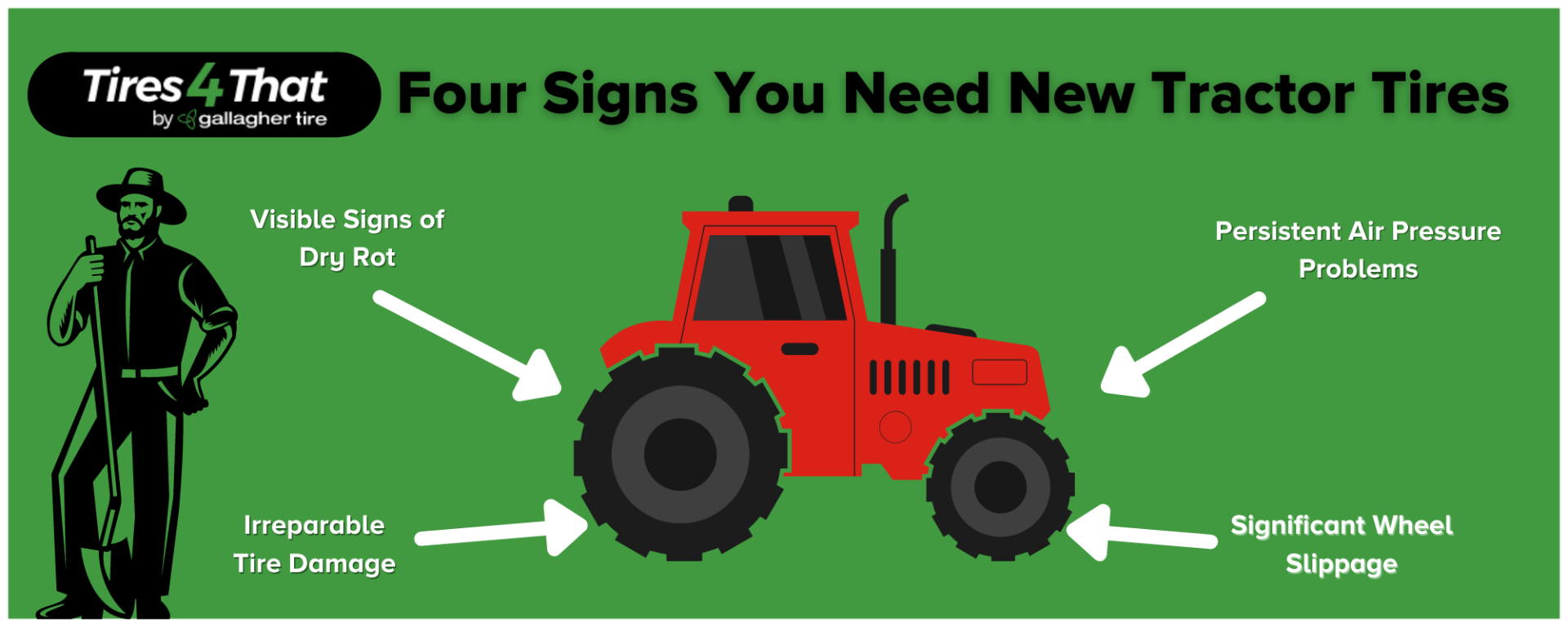How You Know it’s Time to Replace Your Worn-Out Tractor Tires
For farmers across the nation, their farm equipment, especially tractors, represents a significant investment. They have placed time, money, and effort into making their equipment as smooth and efficient as possible, but one area that can be often overlooked is their tires. Knowing when the best time to change their tires can be challenging if you don’t know the signs to look for or if you treat them the same as automobile tires.
Tractor tires and automobile tires, while at their core carry the same purpose, are very dissimilar and require their own level of care. Unlike automobile tires that mainly consider tread depth when determining whether or not they need replacing, tractor tires assess quality on a whole other scale, as indicated in the video below:
Why is it Important to Replace Worn-Out Tires?
Automobiles that travel at high speeds on a worn-down tire with diminishing tread depth are at risk of experiencing a very serious blowout. On the other hand, while worn-out and damaged tires are dangerous for tractors, they’re more costly than anything. An impact on performance can significantly increase fuel consumption and lead to costly downtime. Your tractor will try to compensate for the decreased efficiency of your worn tires and the poor traction.
It’s Time to Replace Your Tires
When it comes time to replace your tires, check out Titan tires for sale on our online shop. However, you’ll first want to inspect each tire thoroughly for some common problems. Keep the following tips and infographic in mind when doing so:

Dry Rot
Like other kinds of tires, your tractor tires can develop dry rot over time without a proper maintenance routine. The natural cycle of seasonal changes can change the composition of the tires. Over-exposure to sunlight and dry air can create cracks and lower the overall elasticity of the material, otherwise known as dry rot. If you notice that your tires have become brittle, faded, or cracked, dry rot has set in, and it’s time for you to change your tires.
Check for Tire Damage
In addition to dry rot, tires endure grueling conditions and travel on both hard and soft terrain, making it essential to inspect them regularly to ensure they are intact. Different tires are built for different terrain, so if your tires are designed specifically for use in the fields but see regular use on pavement, they will wear down faster. If your tires begin to show cords, that’s a sure sign that they need replacing.
Tread Depth
The depth of your agriculture tire treads has a direct impact on the quality of your ride. The more you take your tractor out for work, the more quickly the tread will wear out; it's the natural life cycle of any tire. However, when it comes to farming and construction tires, the kind of terrain your tires encounter will directly affect your tread depth.
If your farming tires go onto concrete and paved roads often enough, the tread pattern on your tires will wear down more quickly and lead to you needing new tire replacements before you should. Your tires will respond differently to various soil conditions, and as you transition from one surface to another, it remains an additional factor you should monitor.
Air Pressure Problems
Like tires for other vehicles, tractor tires rely on precise air pressure to properly and efficiently operate. Optimal tire pressure makes your ride smoother, improves fuel economy, and generally makes your tractor experience better. When issues with your air pressure arise, such as constantly needing to refill your tire’s air, you may have a slow leak that’s affecting performance. When it gets to the point where you can no longer tolerate the cycle of constantly refilling your tire’s air pressure, it’s time for a replacement.
Monitor Wheel Slip
Understanding and monitoring wheel slip is essential when operating a tractor. The wheel slip is a key variable in assessing the efficiency of traction of the tractor tire. A low wheel slip could be affecting other parts of your tractor, causing strain on the machine that is forced to haul excess weight. Replacing old, worn-out tires with new ones will result in optimal performance and fuel savings.
Consider Bias or Radial Tires
Designs for tractor tires continue to evolve as manufacturing technologies progress; however, the decision to choose radial or bias tires is still difficult to make. Old-fashioned bias tires are designed by layering multiple plies of rubber over one another. The sidewall and tread of bias tires work together and provide a firm and durable finish. On the other hand, radial tires are manufactured with a more flexible sidewall, allowing for increased fuel efficiency, better traction, and reduced field damage.
Do you think you know exactly when you should change your tires? With our latest quiz, you can test that! Take our quiz and see if it’s about time to change your tractor tires today!
If, after a thorough inspection, you decide it’s time to replace your tractor tires, trust Tires4That.com to supply you with top-of-the-line options from industry-leading brands. Browse our website for quality tractor tires or to buy tires for construction vehicles online!
